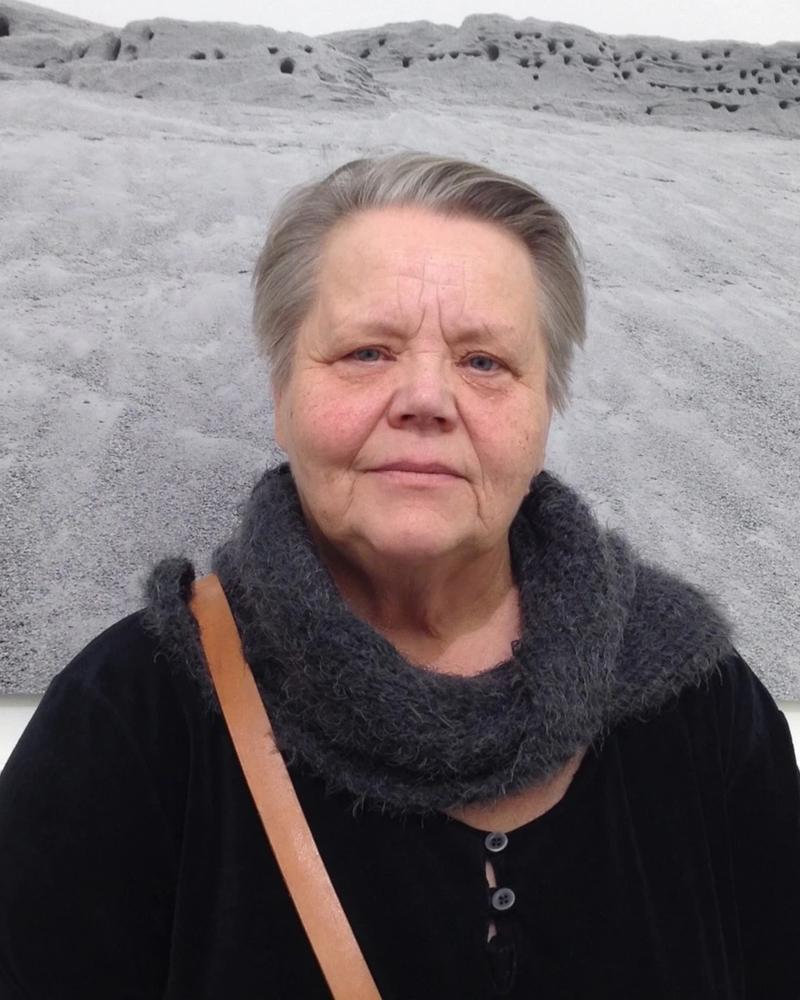Tuija Lindström
Tuija Lindström was a renowned Finnish-Swedish photographer who, in 1992, was the first woman to be appointed professor at the School of Photography and Film at the University of Gothenburg, Sweden (appointing a female photographer to the post of professor of photography in Sweden in the early 1990s was, regrettably, not without controversy). A position she held until 2002, establishing a Master Programme whilst laying the foundations for ongoing photographic research. Lindström explored the theme of naked female bodies, working in the genre for several years until her work culminated, in the early 1990s, in the celebrated conceptual suite Kvinnorna vid Tjursjön / The Girls at Bulls Pond (1991 - 1992). Twelve black and white photos of women floating (in various poses) in a dark lake were hung side by side with twelve monumental photos of irons, creating a tension between the wet, light-coloured bodies and the sharp contours of the irons. About half of the irons were covered with a red colour, reminiscent of blood. The work was also accompanied by a black and white 16 mm film. Lindström’s pictures at this time addressed feminist issues, but from a different perspective than had previously been customary in Sweden.
Born in Kotka, Finland in 1950 (in several interviews Lindström spoke about her difficult childhood in the harbour town), she moved to Stockholm in 1975 where she studied at Konstfack. University of Arts, Crafts and Design (1981 - 1984). At Konstfack Lindström experimented with large format cameras and advanced darkroom techniques and became famous for a series of intimate black and white portraits of friends and cultural figures. Among them the iconic double portrait Jonas and Jussi (1982, gelatin silver photograph, 22 x 27.8 cm), acquired by Moderna Museet, Stockholm in 1985, in which the young author and activist Jonas Gardell (born 1963) looks towards us, with his companion Jussi tenderly leaning on Gardell’s shoulder.
Tuija Lindström belonged to the circle around the legendary photographer Christer Strömholm (1918 - 2002), who developed traditional black-and-white photography towards more personal and artistic projects. Strömholm’s death coincided with the end of Lindströms tenure as professor at the School of Photography and Film in Gothenburg. During Lindström’s ten years at the University there was, as pointed out by Anna Tellgren (PhD, curator of photography at Moderna Museet, Stockholm. Previously researcher and lecturer at the Department of Art History at Stockholm University), ‘a shift in teaching towards a more theoretical approach, which had a major impact on the students who graduated during this period’ and Lindström ‘became a strong role model during these years, especially for many female photographers in Sweden and the other Nordic countries.’
When her time in Gothenburg came to an end, Lindström lived on the Swedish island of Öland for a few years but later moved back to Stockholm. Her later works include a series of colour images of carnivorous plants set against a white background. Throughout her career, she continued to experiment and innovate in her work with portraits, landscapes and still lifes. The feminist perspective was always present in her work.
Lindström has held several international solo exhibitions in places like: Galleri Mira, Stockholm (1986); Galleri Billedhuset, Copenhagen (1986); Galleri Hippolyte, Helsinki (1987); Axiom Center, Cheltenham, United Kingdom (1987); Galleri Hippolyte, Helsinki (1988); WAM Wäinö Aaltonen Museum, Turku, Finland (1989); Fotografiskt Galleri, Oslo (1990); Galerie du Château, Nice, France, (1990); Galleri Laterna Magica, Helsinki (1991); Victor Barsokevitz Museum, Kuopio, Finland (1992); Galerie Suzel Berna, Paris (1993); Gothenburg Art Museum, Gothenburg, Sweden (1993); Galleri 54, Gothenburg (1995); Ars Nova, Museum of Contemporary Art, Turku (1997); Schaper Sundberg Galleri, Stockholm (1998); Gothenburg Art Museum (2000); Capellagården, Vickleby, Sweden (2002); MAN Museum Anna Nordlander, Skellefteå, Sweden (2003) and Galleri SubBau, Gothenburg (2003).
Tuija Lindström had a major retrospective, Tuija Lindström. Look at Us, at Liljevalchs Konsthall (Liljevalchs Public Art Gallery), Stockholm in 2004. Her 2012 exhibition A Dream If Ever There Was One at the Hasselblad Center in Gothenburg presented an overview of her work including landscapes, portraits, nudes and still lifes in collaboration with Helsinki’s Finnish Museum of Photography. After this further exhibitions followed at the Swedish Institute in Paris in 2014 and the Finnish Museum of Photography in Helsinki, 2014.
Lindström is represented in several international collections like: Moderna Museet, Stockholm; Suomen Pankki / The Bank of Finland, Helsinki; the Finnish Museum of Photography, Helsinki; Galerie Suzel Berna, Paris; the Gothenburg Museum of Art, Gothenburg; the Hasselblad Center, Gothenburg; Houston Art Museum, Houston, Texas, U.S.A.; Kalmar konstmuseum, Kalmar, Sweden; the Swedish Institute, Paris; Det Kongelige Bibliotek / Royal Library, Copenhagen; Lunds konsthall, Lund, Sweden; Malmö konsthall, Malmö, Sweden; MAN Museum Anna Nordlander, Skellefteå, Sweden; WAM Wäinö Aaltonen Museum, Turku and Västerbottens Museum, Umeå, Sweden among others.
Tuija Lindström passed away, after a long illness, in Stockholm in 2017.
Copyright Firestorm Foundation
